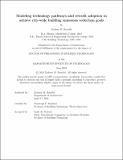Modeling technology pathways and retrofit adoption to achieve city-wide building emissions reduction goals
Author(s)
Berzolla, Zachary M.
DownloadThesis PDF (15.40Mb)
Advisor
Reinhart, Christoph F.
Terms of use
Metadata
Show full item recordAbstract
Achieving net zero emissions from buildings by 2050 is an unprecedented challenge that will require an all-in effort at local, state, federal, and international levels. The exact path to reach this goal in existing buildings varies widely from one community to another. Thus local planning efforts and a bottom-up approach is needed to attain emissions reduction goals. This dissertation lays out a framework to create technology pathway roadmaps to help cities around the world identify actionable strategies to achieve their building emissions reduction goals. These “technical potential” roadmaps can help policymakers quantify the exact requirements in terms of retrofits, workforce, and material to attain their end goals. The application of these tools in 24 cities around the world are discussed. A sound roadmap is only as good as its implementation, and currently retrofit rates lag what is necessary to achieve 2050 goals on time. One of the oft-cited barriers to retrofit adoption is the high upfront cost. This dissertation documents a survey carried out by the author and the resulting model used to help quantify households’ willingness to pay for retrofits. Leveraging the willingness to pay model enables policymakers to analyze the techno-economic pathways to their goals. Finally, one of the greatest challenges to achieve emissions reduction goals is the timeline of retrofit adoption. Under the current business as usual retrofitting rate, less than a fifth of the building stock will be retrofitted by 2050. To help policymakers grasp this temporal challenge, this dissertation introduces a novel application of technology diffusion models that can quantify retrofit adoption over time. The tools developed in this dissertation are aimed at providing communities of all sizes with data-driven insights to meet their ambitious but necessary building-related decarbonization goals in a timely manner.
Date issued
2024-05Department
Massachusetts Institute of Technology. Department of ArchitecturePublisher
Massachusetts Institute of Technology